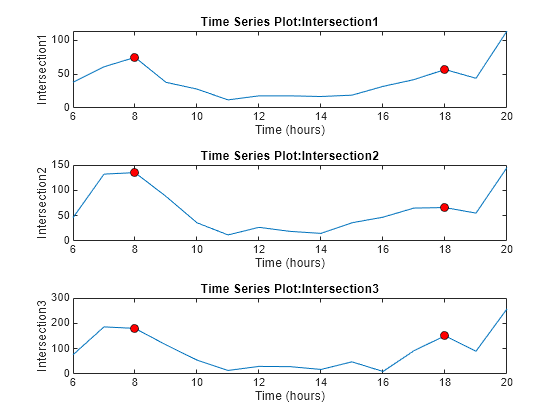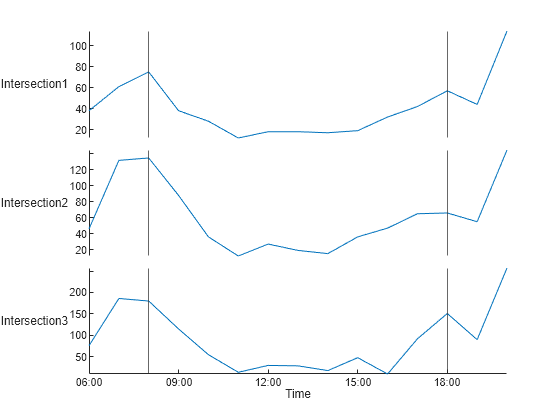timeseries2timetable
Description
TT = timeseries2timetable( converts
ts)timeseries objects to a timetable.
If
tsis atimeseriesobject, thenTTis a timetable with one variable.If
tsis an array oftimeseriesobjects, thenTTis a timetable with as many variables as there aretimeseriesobjects ints. All of thetimeseriesobjects intsmust have the same sample times.If any
timeseriesobject has events, then the function converts the events to an event table and attaches the event table toTT. Duplicate events result in duplicate rows in the event table. (since R2024b)
Examples
Create a timeseries object that has five random numbers, sampled at 10-second intervals.
ts = timeseries(rand(5,1),[0 10 20 30 40])
timeseries
Common Properties:
Name: 'unnamed'
Time: [5x1 double]
TimeInfo: [1x1 tsdata.timemetadata]
Data: [5x1 double]
DataInfo: [1x1 tsdata.datametadata]
More properties, Methods
Display the times and data in ts.
ts.Time
ans = 5×1
0
10
20
30
40
ts.Data
ans = 5×1
0.8147
0.9058
0.1270
0.9134
0.6324
Convert ts to a timetable.
TT = timeseries2timetable(ts)
TT=5×1 timetable
Time Data
______ _______
0 sec 0.81472
10 sec 0.90579
20 sec 0.12699
30 sec 0.91338
40 sec 0.63236
Create an array of timeseries objects. Use the same vector of sample times, but give the time series different names. Create different arrays of data values by using the rand function.
ts1 = timeseries(rand(5,1),[0 10 20 30 40],"Name","Series_1"); ts2 = timeseries(rand(5,1),[0 10 20 30 40],"Name","Series_2"); ts3 = timeseries(rand(5,1),[0 10 20 30 40],"Name","Series_3"); ts = [ts1 ts2 ts3]
1×3 timeseries array with properties:
Events
Name
UserData
Data
DataInfo
Time
TimeInfo
Quality
QualityInfo
IsTimeFirst
TreatNaNasMissing
Length
Combine the data from all the timeseries objects into one timetable. Each time series in the array contributes a variable to the timetable.
TT = timeseries2timetable(ts)
TT=5×3 timetable
Time Series_1 Series_2 Series_3
______ ________ ________ ________
0 sec 0.81472 0.09754 0.15761
10 sec 0.90579 0.2785 0.97059
20 sec 0.12699 0.54688 0.95717
30 sec 0.91338 0.95751 0.48538
40 sec 0.63236 0.96489 0.80028
Convert multiple timeseries objects to a timetable.
ts1 = timeseries(rand(5,1),[0 10 20 30 40],"Name","Series_1"); ts2 = timeseries(rand(5,1),[0 10 20 30 40],"Name","Series_2"); ts3 = timeseries(rand(5,1),[0 10 20 30 40],"Name","Series_3"); TT = timeseries2timetable(ts1,ts2,ts3)
TT=5×3 timetable
Time Series_1 Series_2 Series_3
______ ________ ________ ________
0 sec 0.81472 0.09754 0.15761
10 sec 0.90579 0.2785 0.97059
20 sec 0.12699 0.54688 0.95717
30 sec 0.91338 0.95751 0.48538
40 sec 0.63236 0.96489 0.80028
Load three timeseries objects that have vehicle traffic data for three city intersections.
load trafficCounts.mat count1 count2 count3
Display the properties of the first timeseries object. The properties store the traffic data, the times at which the data was collected, and two events. The events are tsdata.event objects.
count1
timeseries
Common Properties:
Name: 'Intersection1'
Time: [15x1 double]
TimeInfo: [1x1 tsdata.timemetadata]
Data: [15x1 double]
DataInfo: [1x1 tsdata.datametadata]
Events: [1x2 tsdata.event]
More properties, Methods
Display the first event attached to count1.
count1.Events(1)
EventData: []
Name: 'AMCommute'
Time: 8
Units: 'hours'
StartDate: ''
Display the second event. The events label the times of the morning and evening commutes.
count1.Events(2)
EventData: []
Name: 'PMCommute'
Time: 18
Units: 'hours'
StartDate: ''
Plot the data from the three timeseries objects. To create a tiled chart layout for displaying the time series in subplots, use the tiledlayout function. The chart displays red dots to mark the events associated with the three time series.
tiledlayout(3,1) nexttile plot(count1) nexttile plot(count2) nexttile plot(count3)

Convert the three timeseries objects to one timetable. Set the format of the row times to the hh:mm format. The events happen at the same times in the three time series, so the timetable has three event labels at both 08:00 and 18:00.
TT = timeseries2timetable(count1,count2,count3);
TT.Time.Format = "hh:mm"TT=15×3 timetable with 6 events
Time Intersection1 Intersection2 Intersection3
_____ _____________ _____________ _____________
06:00 38 46 76
07:00 61 132 186
<3 events> 08:00 75 135 180
09:00 38 88 115
10:00 28 36 55
11:00 12 12 14
12:00 18 27 30
13:00 18 19 29
14:00 17 15 18
15:00 19 36 48
16:00 32 47 10
17:00 42 65 92
<3 events> 18:00 57 66 151
19:00 44 55 90
20:00 114 145 257
The conversion also converts the event objects to an event table. The event table is attached to the timetable. The event table shows that it has three identical events at two times.
TT.Properties.Events
ans = 6×1 eventtable
Event Labels Variable: EventLabels
Event Lengths Variable: <instantaneous>
Time EventLabels
_____ ___________
8 hr "AMCommute"
8 hr "AMCommute"
8 hr "AMCommute"
18 hr "PMCommute"
18 hr "PMCommute"
18 hr "PMCommute"
You can clean an event table that has repeated events. One approach is to use the unique function.
ET = TT.Properties.Events; ET = unique(ET)
ET = 2×1 eventtable
Event Labels Variable: EventLabels
Event Lengths Variable: <instantaneous>
Time EventLabels
_____ ___________
8 hr "AMCommute"
18 hr "PMCommute"
Attach the cleaned event table to the timetable. Display the timetable.
TT.Properties.Events = ET
TT=15×3 timetable with 2 events
Time Intersection1 Intersection2 Intersection3
_____ _____________ _____________ _____________
06:00 38 46 76
07:00 61 132 186
AMCommute 08:00 75 135 180
09:00 38 88 115
10:00 28 36 55
11:00 12 12 14
12:00 18 27 30
13:00 18 19 29
14:00 17 15 18
15:00 19 36 48
16:00 32 47 10
17:00 42 65 92
PMCommute 18:00 57 66 151
19:00 44 55 90
20:00 114 145 257
Create a chart of the traffic data in the timetable. First create a new figure window so that you do not reuse subplots that were created by tiledlayout. Then, to plot data from the timetable, use stackedplot. The stackedplot function plots each timetable variable in a subplot and displays vertical black lines at the times that events occur.
figure stackedplot(TT)

Input Arguments
Input time series, specified as an array of timeseries
objects.
This function uses some of the properties of ts to either assign
data or set properties in the timetable. For each timeseries
property, the table describes the result in the output timetable.
Input | Result in Output Timetable |
|---|---|
| Specifies the name of the corresponding timetable variable. If |
| Specifies the data assigned to the corresponding timetable variable. |
| Sets the |
| Sets the |
| Converts sample times to row times of the timetable. The vector of
row times is either a |
| Specifies units for row times. If the vector of timetable row times
is a |
| Sets the format for row times. |
| Sets the |
| Sets the |
| Calculates the offset from |
| Determines if the data needs to be reoriented. |
| Specifies the data assigned to the |
| Converts events to entries in an event table and attaches the event table to the timetable. (since R2024b) Duplicate events from the input time series result in duplicate rows in the event table. |
| Warns. |
| Warns if |
Version History
Introduced in R2021aYou can convert timeseries objects that have events to a timetable that
has an event table. When timeseries2timetable converts
timeseries objects to a timetable, it also converts all associated
tsdata.event objects to an event table. Then the function attaches the
event table to the timetable.
Before R2024b, timeseries2timetable ignored events when converting
timeseries objects to a timetable.
The ts2timetable function is now named
timeseries2timetable. The behavior of this function remains the same,
and existing instances of ts2timetable in your code continue to work as
expected. There are no plans to remove support for existing references to
ts2timetable.
MATLAB Command
You clicked a link that corresponds to this MATLAB command:
Run the command by entering it in the MATLAB Command Window. Web browsers do not support MATLAB commands.
Website auswählen
Wählen Sie eine Website aus, um übersetzte Inhalte (sofern verfügbar) sowie lokale Veranstaltungen und Angebote anzuzeigen. Auf der Grundlage Ihres Standorts empfehlen wir Ihnen die folgende Auswahl: .
Sie können auch eine Website aus der folgenden Liste auswählen:
So erhalten Sie die bestmögliche Leistung auf der Website
Wählen Sie für die bestmögliche Website-Leistung die Website für China (auf Chinesisch oder Englisch). Andere landesspezifische Websites von MathWorks sind für Besuche von Ihrem Standort aus nicht optimiert.
Amerika
- América Latina (Español)
- Canada (English)
- United States (English)
Europa
- Belgium (English)
- Denmark (English)
- Deutschland (Deutsch)
- España (Español)
- Finland (English)
- France (Français)
- Ireland (English)
- Italia (Italiano)
- Luxembourg (English)
- Netherlands (English)
- Norway (English)
- Österreich (Deutsch)
- Portugal (English)
- Sweden (English)
- Switzerland
- United Kingdom (English)